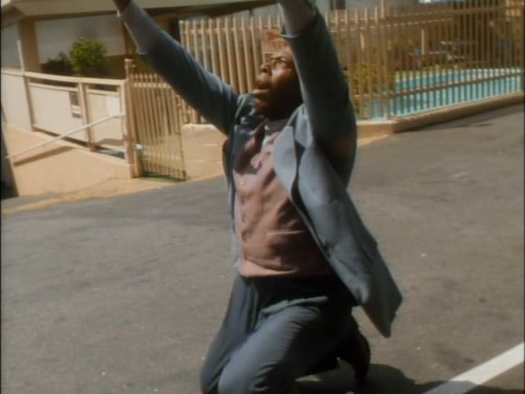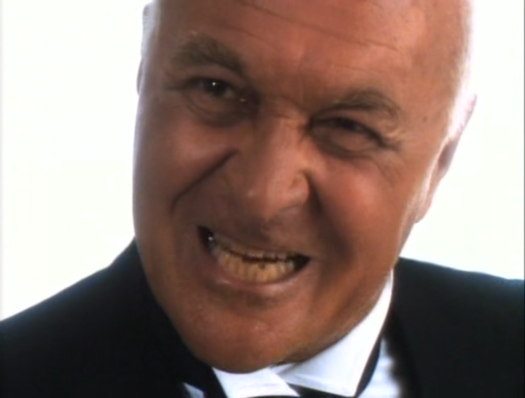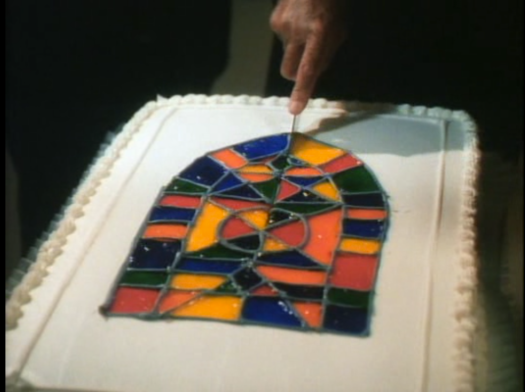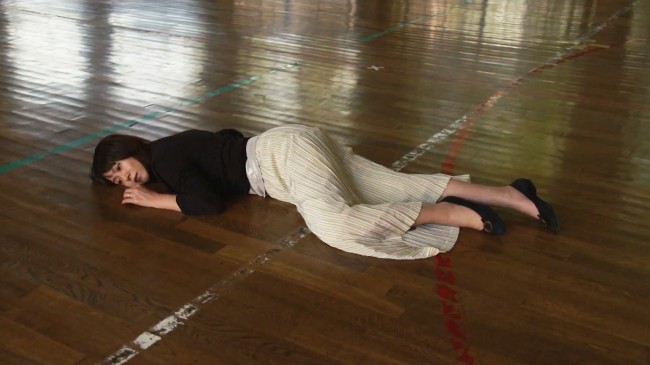Wild Palms is one of those TV Series, along with Twin Peaks – and Hannibal to cite something more recent – that I particularly fashioned because of theirs disturbing, hypnotizing concepts and developments. And actually, Wild Palms has the same kind of atmosphere palpable in David Lynch‘s two seasons complex thriller.
Bruce Wagner, the brain behind this mini-series, collaborated with Oliver Stone in order to produce his creation, and this is not to ignore.
Anyway, risking to sound too pretentious, I believe Wild Palms is a TV Show that only cinephiles could appreciate in its whole, and might never forget like one couldn’t forget Inland Empire. It has complex dynamics, and a listing of art references, being the exquisite centenary wine touching the lips of an oenologist, of a thirsty cinephile.
 Truce poetry. Wild Palms is divided in six parts; the pilot, “Everything Must Go” / “The Floating World covered part 1 and 2, and was directed by Peter Hewitt and Keith Gordon. We are directly introduced to confrontations such as reality and dreams, technological advance and religion, violence and mystery; Cronenberg and Lynch.
Truce poetry. Wild Palms is divided in six parts; the pilot, “Everything Must Go” / “The Floating World covered part 1 and 2, and was directed by Peter Hewitt and Keith Gordon. We are directly introduced to confrontations such as reality and dreams, technological advance and religion, violence and mystery; Cronenberg and Lynch.
 Harry Wyckoff (James Belushi) is our guy, he’s married to Grace (Dana Delany), has two children; a boy, Coty (Ben Savage) and a girl, Deirdre: what a perfect nuclear family.
Harry Wyckoff (James Belushi) is our guy, he’s married to Grace (Dana Delany), has two children; a boy, Coty (Ben Savage) and a girl, Deirdre: what a perfect nuclear family.
Harry is a lawyer, and a successful one, and until he ran into Paige Katz (Kim Cattrall), his first love, everything was almost okay. Catalyzer. Harry is introduced by her, to senator Tony Kreutzer (Robert Loggia), leader of the Synthiotic, a religious sect (parallelism with the scientology), who happened to create a revolutionary visual technology; the Mimecon; allowing to project holograms, later used in television where the news, movies, TV shows etc would happen in your living room, bedroom or whatever.
The most exciting thing, is the mini-series’ construction, as a dream, with strong blinding lights in background and blurry halos, and it emphasizes a lot on that, and technology of holograms, focusing then on perception and visual accessibility. Wild Palms is really pointing out what our eyes might see, what we can observe, how we can distinct reality from imaginary and illusions, and maybe what we can experience, like a drug experience, from those.
The character of Senator Kreutzer wants to take his technology to the next level, and enter people’s dreams, in order to conquer our unconscious, an unknown, and un-flagged territory, letting madness and ferocity burn him from the inside.
Eccentric characters, threatening world(s), voyeurism and obsession of power, everything is basically set in the pilot. 
 Part III – “Rising Sons” directed by Kathryn Bigelow
Part III – “Rising Sons” directed by Kathryn Bigelow
In this episode, you are more informed about the “Fathers” and “Friends” opposed, almost-political, teams, the dictators/the totalitarians, ordered and neat and the revolutionary, scattered, and ferociously courageous.
Obviously, Kreutzer is one of the Fathers, they are recognizable by the tattoo of a palm tree on their hands. They are vicious, perverse, they kidnap their enemies’ kids and replace them by theirs. This highlights the double connotation of the word “father” which primary meaning looses its status.
Thus, a crucial element must be evoked here, the rhinoceros; indeed, this animal appears in Harry’s dreams, it is an image that is used by the Fathers and the synthetic church, and here the symbolism is taken from Eugène Ionesco‘s play Rhinoceros, in which people turn into rhinoceroses. It is reminding the dictatorial aspect of the Fathers, wanting to impose their power to the population, and for that has to use the control of the mass and the establishment of a kind of uniformity.
 So, Wild Palms openly plays on references, metaphors, visual spectacles and the essence of originality and fine and unique core, is centered in the script, and of course, its transposition into images.
So, Wild Palms openly plays on references, metaphors, visual spectacles and the essence of originality and fine and unique core, is centered in the script, and of course, its transposition into images.
Part IV and V that aren’t together, but I am only discussing something in part IV. “Hungry Ghost” and “Hello, I Must Be Going” directed respectively by Keith Gordon and Phil Joanou.
I was chocked, and it isn’t quite the right word to describe my reaction when I saw “MAPS TO THE STARS” written with capital letters on a white wall in part IV.
The cronenbergian technological advances cited in Wild Palms, reached the extent of being predicative; of Cronenberg’s new movie. The connection between those two pieces of art is more than relevant, this coincidence was extraordinary well placed.
 But this is only an anecdote. Then, to wrap up, Wild Palms is a great mini-series, that would have been an outstanding movie or a revolutionary TV Show of a dozen of seasons, because of its potential, and possession of its looking-like infinite resources. It is an experience, a cinematic experience, a dystopia mixing economy, politic, religion and development. A dystopia that mixes our past, present and future. It’s an exhaustive work, translating a meticulous study on symbolism in art.
But this is only an anecdote. Then, to wrap up, Wild Palms is a great mini-series, that would have been an outstanding movie or a revolutionary TV Show of a dozen of seasons, because of its potential, and possession of its looking-like infinite resources. It is an experience, a cinematic experience, a dystopia mixing economy, politic, religion and development. A dystopia that mixes our past, present and future. It’s an exhaustive work, translating a meticulous study on symbolism in art.



